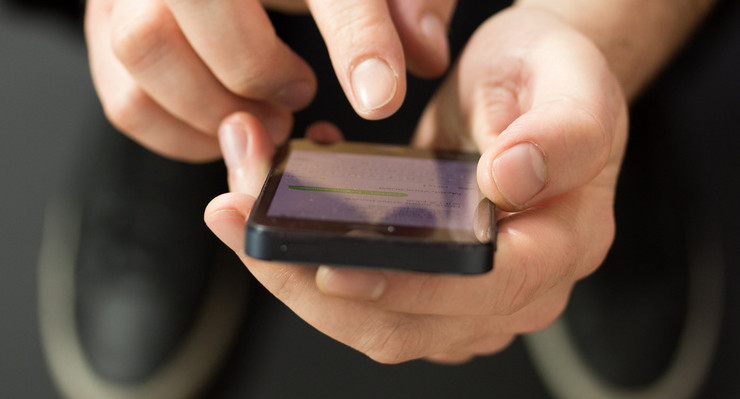
close up on a man uses his mobile phoneLast month Mary Meeker released her much anticipated 2016 Internet Trends Report, which she’s been compiling every year since 2001. Characterized by Fortune‘s Andrew Serwer as “absolutely first rate when it comes to spotting big-picture trends before they come into focus,” the Kleiner Perkins partner was named one of the ten smartest people in tech by the same publisher in 2010, and listed as the 77th most powerful woman in the world by Forbes in 2014. In short, when she talks, you should listen.
We’ll concentrate on what retailers can learn about mobile marketing strategies from Meeker’s watchful analysis. Some broad trends to consider before we go further:
- The 2015 global internet adoption rate is 9% year-over-year, which matches the previous year’s rate, and reaches 42% of the world’s population (3 billion).
- On average, Americans are spending 5 hours daily on mobile devices.
- US advertisers spent 66% more on mobile ads in 2015 than 2014, and only 5% more on desktop ads.
- Internet advertising growth is up 20% owing to mobile (up 66%) versus a 5% rise in desktop.
Ways to spell Mobile Engagement
Meeker’s report focuses on several trends that should be of interest to retail marketers and their mobile marketing strategies. For starters, there is less differentiation between products, brands, and retailers. Products evolve into brands, brands become retailers (via manufacturer direct online ordering), and retailers become products (by launching private labels/house brands). This means that retailers need to invest more effort to differentiate. Digital coupons should be the drive-to-store element in a wider engagement strategy. Whether you’re promoting a sale by SMS using mobile coupons or sending out emails to subscribers, always think about the experience of mobile users, and optimize your efforts accordingly.
Differentiation by Personalization
Meeker reports that internet-enabled retailers are on the rise, and creative personalization that solves a problem — like visualizing how a product will look in your home or enabling you to try on suggested clothes at home, two mini-case studies from her report detailed below — is an excellent way to attract and retain customers.
Houzz launched View In My Room, an app that enables one to pick a product and preview what it looks like in any room, through the phone’s camera. Half of the users who made a purchase used the View In My Room app. Meeker points out how these app users were found 97% more likely to use Houzz next time they shop and are 5.5 times more likely to purchase.
Stitch Fix advertises “Clothing and accessories hand-selected by a personal stylist, delivered to your door.” The folks at Stitch Fix found a way to bring Netflix and Spotify-style content discovery to fashion using a data-driven onboarding process, where data points on customer preferences, style, and activities are collected. Stylists use these Pinterest boards and specialized algorithms to help improve product selection. They ship ‘fixes’ with curated items based on client preferences or style. Nearly all of these fixes shipped are unique, giving each client a differentiated experience. Thirty-nine percent of Stitch Fix clients get the majority of their clothing from Stitch Fix, up from less than 30% of clients a year ago.
Personalization can also include making sure shoppers get messages and promotions that relate to their needs, connecting on that personal level. Done successfully, you can capitalize on the information you know about your customer, which can lead to better engagement and bigger basket size.
Marketers can build campaigns that are based on relevant data collected from previous customer interactions. Personalization can take the shape of one-time-use mobile coupons that are based on collected redemption data. Armed with this data, it’s much easier to segment and build personalized offers that resonate with consumers especially millennials who want that personal, seemingly “curated” touch.
Millennial Spending
Marketing capabilities are important, but so is the market. How well do you know yours? According to Meeker’s report, millennials are 27% of the US population, making them the largest generation. Their spending power will rise significantly in the next 10 to 20 years. Their approach to personal finances is different from previous generations: they earn to spend. The best way for businesses to contact millennials is via social media and web chat, followed by electronic messaging (email and SMS text). The lowest rated communication channel? The telephone.
“Uncovering Truths of Millennial Spending,” a recent industry report by Coupons.com, shared some interesting insights as well. Almost 80% of millennials search for digital coupons using their smartphone. Rather than relying on social media outlets, millennials hunt down deals through email offers (42%) and mobile apps of retailers or companies that provide discounts (36%). The study indicated that two-thirds of millennial parents use mobile coupons for baby products; followed by grocery (60%); household goods (55%); and beauty products (49%).
Millennials love texting and receiving texts so much that 75% polled in a survey said they’d rather give up talking on the phone than give up texting. SMS marketing messages sent by retailers and vendors are more than welcome, they are encouraged. The OpenMarket survey reported how only 30% of millennials receive texts from companies they know and do business with, leaving ample room for mobile marketing growth.
While I’ve cherry-picked some of the most important insights for retailers, these trend surveys are jam-packed with hundreds of additional observations and insights for digital marketers.
